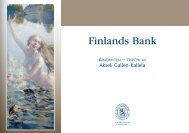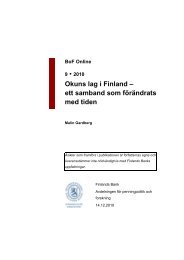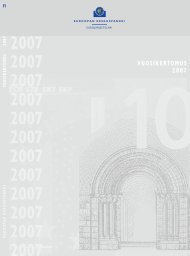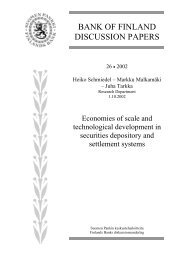Akseli Gallen-Kallela - Suomen Pankki
Akseli Gallen-Kallela - Suomen Pankki
Akseli Gallen-Kallela - Suomen Pankki
You also want an ePaper? Increase the reach of your titles
YUMPU automatically turns print PDFs into web optimized ePapers that Google loves.
Why Aino?<br />
There is no straightforward<br />
answer to the question why<br />
<strong>Gallen</strong>-<strong>Kallela</strong> chose the tragic<br />
story of Aino as the opening work<br />
of his Kalevala themes. However,<br />
the contents of his art studies, the<br />
prevailing spirit of the times and<br />
his personal preferences make it<br />
possible to identify reasons for the<br />
implementation of this motif.<br />
Depiction of the human body<br />
took centre stage in his studies at<br />
the Académie Julian. The aim was<br />
to learn to master anatomic<br />
depiction by practising painting<br />
with live models. The Central<br />
European art life of that time, in<br />
the heart of which <strong>Gallen</strong>-<strong>Kallela</strong><br />
studied, knew a number of<br />
examples of mythic and fatal<br />
women from antiquity, the Bible<br />
and various folk legends.<br />
Throughout the 1880s, dramatic<br />
paintings based on such motifs<br />
reflected a stronger interest in a<br />
romanticising approach towards<br />
the past and a greater idealisation<br />
of early Christianity and the<br />
Middle Ages.<br />
The Aino triptych enabled<br />
<strong>Gallen</strong>-<strong>Kallela</strong> to draw on what he<br />
had learnt and to take account of<br />
the topical currents of the art<br />
world. The three-part triptych<br />
form borrowed from medieval<br />
church art provided the setting for<br />
scenes where Aino’s body language<br />
combined with realistic outdoor<br />
painting. The middle part of the<br />
triptych in particular can be<br />
compared to the scenic, illusory and<br />
even sensational salon art of the time.<br />
<strong>Gallen</strong>-<strong>Kallela</strong>’s mother,<br />
Mathilda Gallén, residing in<br />
Finland, predicted success for her<br />
son and Aino: ‘The Aino legend<br />
will be his great success, but the<br />
forests and lakes of his home<br />
country will inspire him to<br />
correctly understand the legend.<br />
The Aino in the legend must be the<br />
Finnish Juno of art.’ In comparing<br />
Aino with the mythic protectress<br />
of women in antiquity, Mathilda<br />
Gallén came to refer to the<br />
classical origins of our Kalevala<br />
art and to parallels between the<br />
Kalevala epic and global<br />
mythological traditions. What was<br />
new compared with the previous<br />
way of presenting Kalevala themes<br />
in our country, mainly based on<br />
illustrations from antiquity, was<br />
8
















